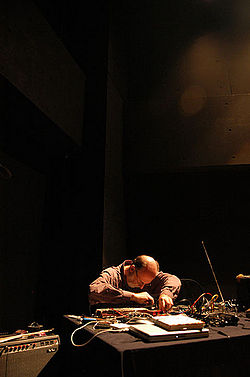History
1800s–1940s
Early electronic instruments

Early electronic instruments intended for live performance, such as Thaddeus Cahill's Telharmonium (1897) and instruments developed between the two world wars, such as the Theremin (1919), Spharophon (1924), ondes Martenot (1928), and the Trautonium (1929), may be cited as antecedents, [2] but were intended simply as new means of sound production, and did nothing to change the nature of musical composition or performance. [3]
Many early compositions included these electronic instruments, though the instruments were typically used as substitutes for standard classical instruments. An example includes composer Joseph Schillinger, who in 1929 composed First Airphonic Suite for Theremin and Orchestra, which premièred with the Cleveland Orchestra with Leon Theremin as soloist.[ citation needed ] Percy Grainger, used ensembles of four or six theremins (in preference to a string quartet) for his two earliest experimental Free Music compositions (1935–37) because of the instrument's complete 'gliding' freedom of pitch.( [4] [5] The ondes Martenot was also used as a featured instrument in the 1930s, and composer Olivier Messiaen used it in the Fête des belles eaux for six ondes, written for the 1937 International World's Fair in Paris. [6]
Cage's Imaginary Landscape No. 1 (1939) was among the earliest compositions to include an innovative use of live electronic material; it featured two variable-speed phonograph turntables and sine-tone recordings. [7] Cage's interest in live electronics continued through the 1940s and 1950s, providing inspiration for the formation of a number of live-electronic groups in America who came to regard themselves as the pioneers of a new art form. [2]
The earliest use of live electronics together with acoustic instruments is in all likelihood Daphne Oram’s Still Point (1948), a work for turntable, double orchestra and five microphones. The work was unperformed until 2016.
1950s–1960s

In Europe, Pierre Schaeffer had attempted live generation of the final stages of his works at the first public concert of musique concrète in 1951 with limited success. However, it was in Europe at the end of the 1950s and early 1960s that the most coherent transition from studio electronic techniques to live synthesis occurred. Mauricio Kagel's Transición II (1959) combined two tape recorders for live manipulation of the sounds of piano and percussion, and beginning in 1964 Karlheinz Stockhausen entered on a period of intensive work with live electronics with three works, Mikrophonie I and Mixtur (both 1964), and Mikrophonie II . [8] While earlier live-electronic compositions, such as Cage's Cartridge Music (1960), had mainly employed amplification, Stockhausen's innovation was to add electronic transformation through filtering, which erased the distinction between instrumental and electronic music. [9]
During the 1960s, a number of composers believed studio-based composition, such as musique concrète, lacked elements that were central to the creation of live music, such as: spontaneity, dialogue, discovery and group interaction. Many composers viewed the development of live electronics as a reaction against "the largely technocratic and rationalistic ethos of studio processed tape music" which was devoid of the visual and theatrical component of live performance. [1] By the 1970s, live electronics had become the primary area of innovation in electronic music. [10]
1970s–1980s
The 1970s and 1980s were notable for contributions by electronic musician Jean-Michel Jarre. The success of Oxygene and his large scale concerts which he performed attracted millions of people, breaking his own record for largest audience four times. [11] [12] [13] ) In fact Jarre continued to break his own records up to the end of the century, with 3.5 million people attending 1997's Oxygene in Moscow. [14]
1990s
Laptronica

Laptronica is a form of live electronic music or computer music in which laptops are used as musical instruments. The term is a portmanteau of "laptop computer" and "electronica". The term gained a certain degree of currency in the 1990s and is of significance due to the use of highly powerful computation being made available to musicians in highly portable form, and therefore in live performance. Many sophisticated forms of sound production, manipulation and organization (which had hitherto only been available in studios or academic institutions) became available to use in live performance, largely by younger musicians influenced by and interested in developing experimental popular music forms. [15] A combination of many laptops can be used to form a laptop orchestra.
Live coding
Live coding [16] (sometimes referred to as 'on-the-fly programming', [17] 'just in time programming') is a programming practice centred upon the use of improvised interactive programming. Live coding is often used to create sound and image based digital media, and is particularly prevalent in computer music, combining algorithmic composition with improvisation, [18] Typically, the process of writing is made visible by projecting the computer screen in the audience space, with ways of visualising the code an area of active research. [19] There are also approaches to human live coding in improvised dance. [20] Live coding techniques are also employed outside of performance, such as in producing sound for film [21] or audio/visual work for interactive art installations. [22]
Live coding is also an increasingly popular technique in programming-related lectures and conference presentations, and has been described as a "best practice" for computer science lectures by Mark Guzdial. [23]
Electroacoustic improvisation

Electroacoustic improvisation (EAI) is a form of free improvisation that was originally referred to as live electronics. It has been part of the sound art world since the 1930s with the early works of John Cage. [24] [25] Source magazine published articles by a number of leading electronic and avant-garde composers in the 1960s. [26]
It was further influenced by electronic and electroacoustic music and the music of American experimental composers such as John Cage, Morton Feldman and David Tudor. British free improvisation group AMM, particularly their guitarist Keith Rowe, have also played a contributing role in bringing attention to the practice. [27]